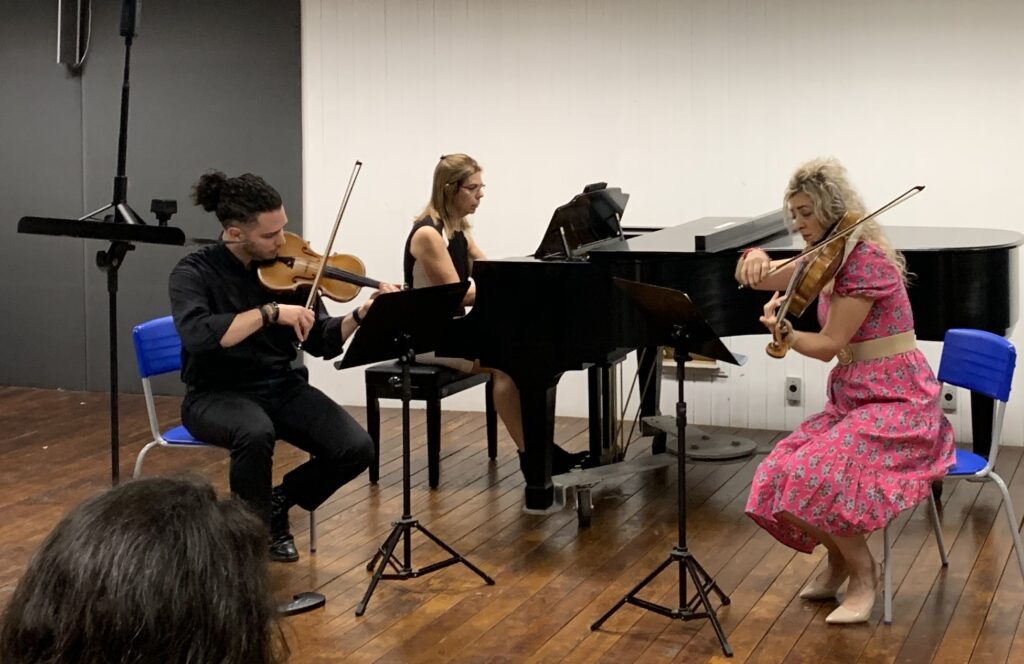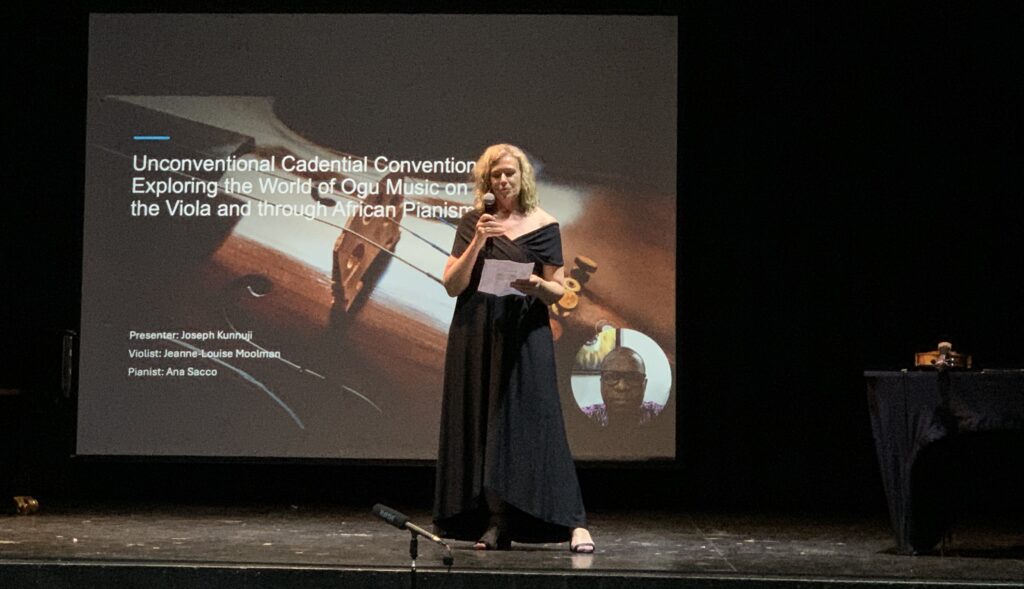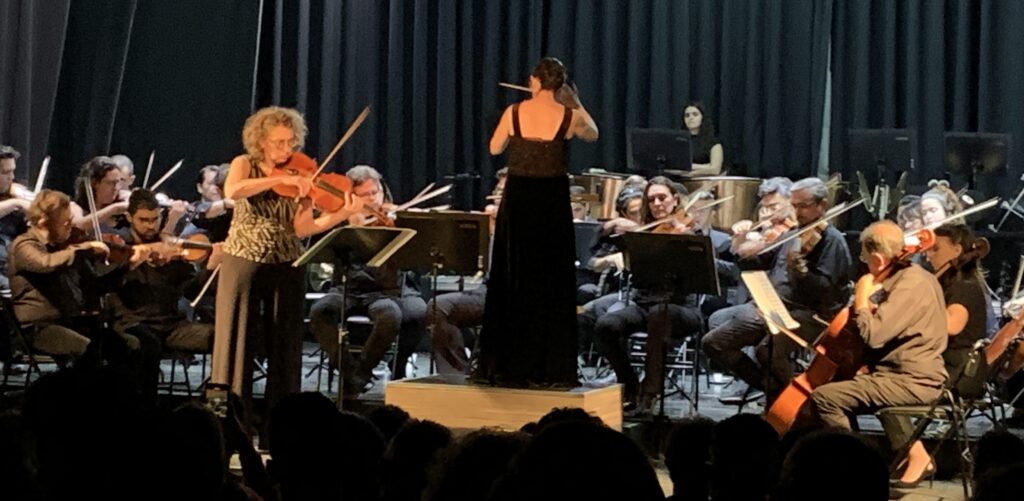The 49th International Viola Congress takes place from 17-21 July (2024) in Campinas, Brazil. Your intrepid DVS bloggers bring you the daily debrief from the pulsating heart of the viola world.
Day 1 – Wednesday, July 17th 2024.
The 49th International Viola Congress kicked off today in Campinas, near São Paulo, Brazil. It is the first time that an IVC is held in South America, so this is truly a milestone! The Host of this year’s congress is prof. Emerson de Biaggi at UNICAMP Institute of the Arts. The attending crowd is strikingly young, with lots of student delegations from all over South America, but especially from Brazil. The Dutch Viola Society is represented by 7 delegates, most of whom will also be performing or presenting at the congress.
 The opening ceremony in the packed main Auditorium of the School of Music offered the customary speeches of welcomes and thanks from the hosts and the IVS President. It was elegantly and playfully wrapped up with two entertaining viola ensemble pieces performed by prof. de Biaggi’s own viola students. To celebrate the kick-off, we were served a wide variety of Brazilian pasteles, bolos and pãos with coffee and – my favourite – guaranã juice. Along with all the socializing with new and old friends, for many of us this meant skipping a real lunch and diving head-first into the first serious congress sessions.
The opening ceremony in the packed main Auditorium of the School of Music offered the customary speeches of welcomes and thanks from the hosts and the IVS President. It was elegantly and playfully wrapped up with two entertaining viola ensemble pieces performed by prof. de Biaggi’s own viola students. To celebrate the kick-off, we were served a wide variety of Brazilian pasteles, bolos and pãos with coffee and – my favourite – guaranã juice. Along with all the socializing with new and old friends, for many of us this meant skipping a real lunch and diving head-first into the first serious congress sessions.
The first recital session started at 1pm with a world premiere of Matthew Heap’s “Finding Balance” for Viola, Horn and Piano. The spouses Andrea and Albert Houde celebrated their 20th wedding anniversary today with this performance, joined by Luiza A. Salles on the piano.
Camila Meirelles brought us an interesting “local speciality” – a concertino (for viola and piano) that she herself had commissioned in 2016 from the revered José Ursicino da Silva – also simply known as Maestro Duda, composer and conductor from the North-East of Brazil. The composition features some typical rhythmic elements of that region’s traditional music, including the Maracatu and the Frevo
This was followed by a set of popular Brazilian children’s songs, arranged for viola duo by Flavio Chamis. Timothy Deighton and Tatjana Mead Chamis performed with humour and conviction. Stephen Nordstrom painted for us “A Musical Portrait of the American Southwest – Reflections on a Desert Winter”, accompanied on the piano by the composer himself – Dominic Dousa.
At this point, the Congress had already started to run parallel tracks – so the schedule forced us to make tough choices. I apologize in advance to everyone whose presentation I missed (or will miss) and therefore cannot describe here!
Next, I chose to follow the Lecture-recital “Unconventional Cadential Conventions: Exploring the World of Ogu Music on the Viola through African Pianism“. While the Ogu people are spread over several countries on the African West coast, they have a strong common musical “gene”. Ethnomusicologist dr. Joseph Kunnuji delivered a pre-recorded video lecture, explaining some key concepts and harmonic analysis of this music. After this, a number of examples were performed live by Jeanne-Louise Moolman (from South Africa) with Ana Carolina Sacco on the piano . With complex rhythmic patterns and a wide range of tonal expressions, it provided a fascinating peek into an unsuspected musical world.
Meanwhile in the other auditorium, some delays had accumulated, which gave me the chance to hear the last part of Jessé Máximo Perreira’s recital of four premiere viola solo compositions, a tribute to the late Brazilian violist Ricardo Kubala. The last piece, a solo sonata by Marco Padilha, featured a particularly dramatic scordatura. Some of the finer details were unfortunately drowned out by the (indispensable, but rather loud) airco system.
 Those who attended last year’s congress in Salaya (Thailand) were fortunate to witness the premiere of Marco Anzoletti’s viola concerto. Since then, Anzoletti’s work can be said to be in a state of “revival”, and his Trio in b minor (1906) was given a rare outing today by Alicia Valoti (viola), Matheus G. Souza (violin) and Luciana Gastaldi (piano). They skipped the 2nd movement (for schedule reasons), but there was enough evidence of nice melodic viola lines.
Those who attended last year’s congress in Salaya (Thailand) were fortunate to witness the premiere of Marco Anzoletti’s viola concerto. Since then, Anzoletti’s work can be said to be in a state of “revival”, and his Trio in b minor (1906) was given a rare outing today by Alicia Valoti (viola), Matheus G. Souza (violin) and Luciana Gastaldi (piano). They skipped the 2nd movement (for schedule reasons), but there was enough evidence of nice melodic viola lines.
The Polish delegation in Campinas is vital as always. In a program titled “Solo, duo, quattro“, Wojciech Kolaczyk “and friends” performed 3 very authentic Polish compositions: First a commissioned piece for the occasion, a solo piece simply called “Campinas” by Dawid Pajdzik (b.1984). Next, Wojciech was joined by the always dynamic Dutch-Canadian Emlyn Stam in “Duo nr.1” by Przemyslaw Pujanek. The performance drew cheers from the audience, but that would soon be overshadowed by the “Elegia for 4 violas” (again by Dawid Pajdzik). Here the previously mentioned duo was expanded to a quartet by adding Karin Dolman and Marcin Murawski. What a fascinating piece! As a “planned encore”, the merry band gave a rendition of Michael Kimber’s classic “Viola Fight Song”, always good for a laugh.
Kevin Nordstrom rounded off today’s recital sessions. He started off with the solo pieces “Simply Purple” and “Wild Purple” by Joan Tower (b.1938). Most impressive was however his rendition of Sonata Pastorale by the “First Lady of the Viola”, Lillian Fuchs (1904-1995).
After a rather hurried dinner back at the hotel, we reconvened in the main Auditorium for the “Opening night concert”, featuring the Jundiaí Symphony Orchestra under the baton of Claudia Feres and last but not least IVS President Jutta Puchhammer as a soloist. She first performend Sitt’s Concertino op.46, warmly appreciated by the audience, and followed through with Istvan Eröd’s “Fantasia” for viola and string orchestra, composed in 1981 for Thomas Riebl. This rarely heard piece was a very pleasant surprise! It all suited the soloist’s virtuosity and sound shaping very well, and the audience rewarded her with their abundant appreciation.
The orchestra sprinkled the menu with an appetizer by Rossini (ouverture La Gazza Ladra) and a dessert platter by Dvorak (his Slavonic Dances). Never before have I seen an orchestral viola section so passionately applauded, with loud cheers for VIOLA, VIOLA!. It was all very deserved, but viola sections rarely ever get the appreciation they deserve, so savour the moment! This can only ever happen at a Viola Congress!
Kristofer G. Skaug, DVS
PS. More near-real-time news tomorrow!





